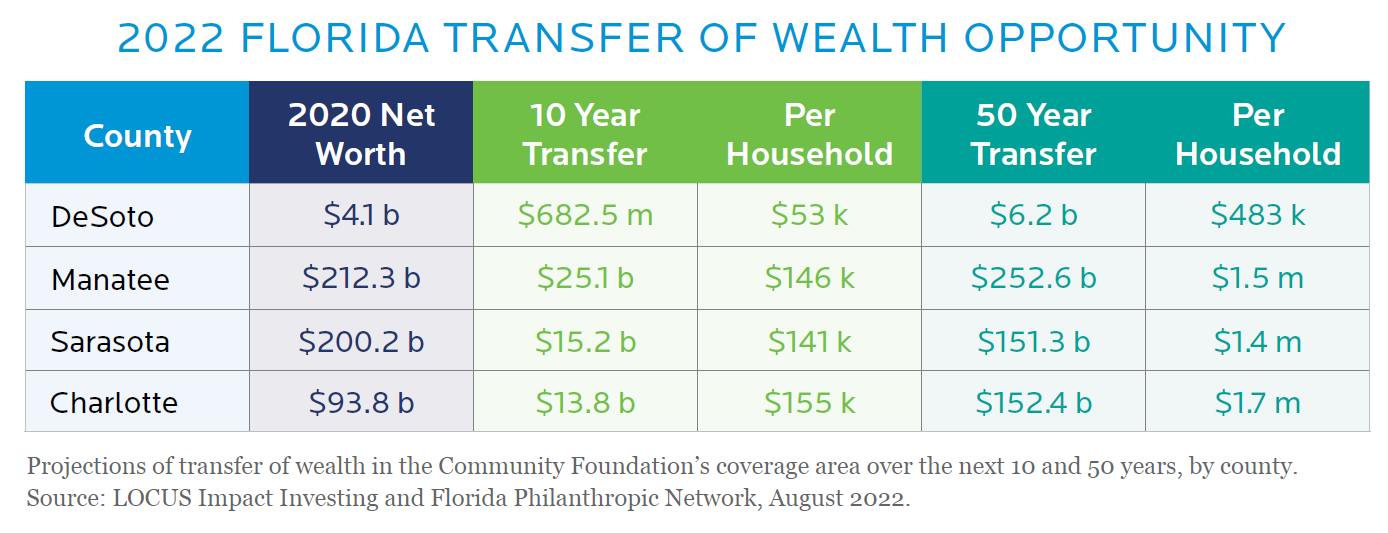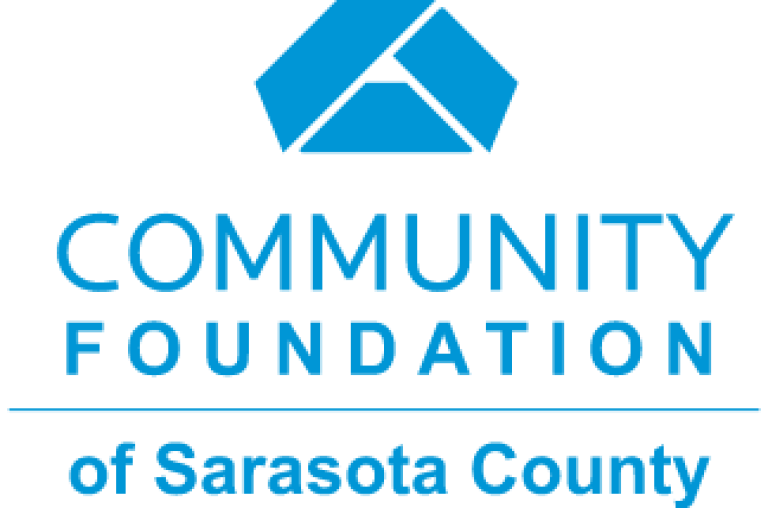June 8, 2023
Report: Future Is Bright, If We Make It So
Categories: Philanthropy,
Our work at the Community Foundation of Sarasota County almost always starts with listening. We listen to learn what the motivations are—personal and collectively—around charitable giving. For nearly 45 years, by listening and learning, we have been invited and trusted to help unite aspirations with action. It is a role expected to grow in the next decade when the largest transfer of wealth will take place across our growing state and region.
According to the 2022 Florida Transfer of Wealth Opportunity Analysis for Florida, released in September 2022 by LOCUS Impact Investing in collaboration with the Florida Philanthropic Network, Florida’s current household net worth is $7.3 trillion. Over ten years, that transfer of wealth will be $884 billion; over the next fifty years, that potential is projected to be $11.3 trillion.
This poises the state for prosperity in the long term. The key to reaching economic vitality, the report finds, is harnessing some of those assets into philanthropy.
“In the four-county area that our Community Foundation covers, there is an estimated $55 billion to be transferred over the next ten years, and billions in the years beyond that,” said Roxie Jerde, President and CEO of the Community Foundation of Sarasota County. “Imagine, if just a small amount of that money was entrusted to philanthropy, how much stronger our communities could be.”
Indeed, the report notes that statewide, capturing just five percent of the state’s transfer of wealth potential would create $44 billion in new endowments in the next decade. The average annual grantmaking potential from those endowments could reach $2.4 billion.
“Communities regularly struggle to overcome the perception that they lack the capacity, the tools, or the know-how to make a lasting change for the better,” the report reads. “Simply understanding the scale of your region’s net worth can be helpful in dispelling that perception and help community members start dreaming about what might be possible.”

Why Philanthropy?
Engaging people in philanthropic giving is a priority, the report notes, as that engagement could mean laying groundwork for more efforts in projects that increase overall community vitality and prosperity, such as catalyzing investments in affordable housing and providing access to high-quality childcare. Philanthropy allows for innovative approaches, such as the twogeneration (2Gen) approach, which strengthens families by investing in parents and children. This strengthens community through broadening employment opportunities for parents. It can also provide gap funding for small businesses, stimulating economic growth and reducing economic inequality.
In our community, we have seen philanthropy do just that: the Community Foundation’s support of Lofts on Lemon and other affordable housing options has created opportunity and provided stability for many of our region’s famlies. Early education programs the Community Foundation supports have been effective in closing the achievement gap and bolstering equity. And of course the 2Gen approach has been a critical piece of empowering families through opening pathways to parent education that lead to more secure, higher paying employment.
More than that, it has underpinned our community’s arts and cultural organizations, which are a major draw for tourists and transplants alike. Our thriving theater, music, and dance organizations, along with our art museums and film festivals all are incredible cultural resources that imbue our community with regional and national cache—all of this is thanks to philanthropy.
Philanthropy is also the backbone of some of our area’s most worthwhile environmental protection efforts—from high-profile entities like Mote Marine and The Bay Park Conservancy to smaller organizations solely focused on water quality, like Suncoast Waterkeeper, philanthropy has been the driving force. Without doubt, the generosity of this community, and the innovative and passionate nonprofit organizations who undertake important work have enriched this community in countless ways.
That said, the report notes that traditional sources of funding—taxes, federal and state funding and the like—have come under pressure in recent years. Philanthropy remains the key—and simultaneously the most underdeveloped financial resource—to community wellbeing.
Reasons to Give Abound
As the report notes, community-based philanthropy is a way for neighbors to invest and realize a shared vision for their region’s future, and that community members of all means can give back to the place they call home.
“Philanthropy can engage community like no other tool because it has the potential to turn dreams into reality,” said Jay Young, Vice President, Philanthropy of the Community Foundation. “Often charitable gifts are the sole (or main) funding source for projects promoting equity and access.”
Another point the report illustrates is the disparity in our four-county service region. Sarasota County has high household wealth, Manatee and Charlotte counties likewise are well resourced. But just to the east, DeSoto county has a current net worth of just $4.1 billion (compared with Sarasota County’s net worth of $200.2 billion). This lack of assets is evident in many key community indicators—DeSoto lags in education, healthcare, and social capital. The study finds that the gap will only increase as time moves on: the 10-year transfer in smaller, poorer DeSoto is just $682.5 million to Sarasota’s $15.2 billion.
Calculating the Transfer
The report’s methodology uses current average household wealth, historical population growth, and forecasted population growth to arrive at its transfer of wealth projections. It’s not news that Florida’s pace of growth is swift—with a current population of 21.7 million residents (as of 2020), the state is projected to reach a population of 30 million by 2050. The mechanism of transfer is the passing of a householder—defined by the report as the head of a household. This means that in regions with aging populations, the transfer will happen more imminently than those areas with younger populations. Authors note that the shorter-term projections (that ten-year transfer of wealth figure) are more reliable than longer-term scenarios. There are also confounding scenarios—like the COVID-19 pandemic—that can drastically derail projections. For that reason, in this study, report authors used 2019 and 2021 when collecting wealth and population figures.
